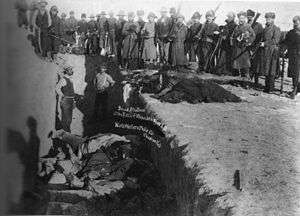Ghost Dance War
The Ghost Dance War was an armed conflict in the United States between the Lakota Sioux and the United States government from 1890 until 1891. It involved the Wounded Knee Massacre wherein the 7th Cavalry massacred around 300 unarmed Lakota Sioux, primarily women, children, and elders, at Wounded Knee on December 29, 1890. The Ghost Dance War ended when Sioux leader Kicking Bear surrendered on January 15, 1891.
| Ghost Dance War | |||||||
|---|---|---|---|---|---|---|---|
| Part of the Sioux Wars | |||||||
 Mass grave for the dead Lakota after the massacre at Wounded Knee Creek. | |||||||
| |||||||
| Belligerents | |||||||
|
|
Miniconjou Lakota Hunkpapa Lakota | ||||||
| Commanders and leaders | |||||||
|
|
Spotted Elk † Kicking Bear | ||||||
| Casualties and losses | |||||||
|
~25–50 killed 39 wounded |
~300 killed 51 wounded | ||||||
|
| |||||||
Ghost Dance
The Ghost Dance ceremony began as part of a Native American religious movement in the late 1800s. It was initiated by the Paiute religious leader Wovoka, after a vision in which Wovoka said God spoke to him and told him directly that by practicing this ceremony, the white man would leave and the Native American ancestors would come back to live in peace with the remaining Native Americans for the rest of eternity. This religion quickly spread throughout the entire west and Native American tribes, including the Lakota. The name "Ghost Dance" is actually the name given to it by white settlers who were frightened by this spiritual dance, saying that it had a "ghostly" aura around it. This started the push to bring US troops into the Dakotas where the Sioux were most prominent and where the Ghost Dance was being practiced the most.[1]
War
In the winter of 1890, the Lakota had been upset over a series of treaty violations in the Fort Laramie Treaty of 1851 by the US involving land divisions among tribes in South Dakota and the US running railroads through the reservation. There was also dispute around the Black Hills land where gold was found in 1874. There were a series of battles and assaults upon the indigenous people, the most well known of them being the Wounded Knee Massacre. The Sioux had encamped themselves at Wounded Knee Creek and were handing over their weapons to US troops. One deaf Lakota did not give up his weapon due to the US troops not knowing how to communicate with the deaf Lakota. Some accounts say there was a miscommunication as the man was handing over his gun, and that someone's gun discharged in the air. One of the US commanders heard this and ordered his troops to open fire. The commanders called in reinforcement from the Hotchkiss cannons that were previously placed on the adjacent ridge. These cannons mowed down everyone in range. By the time the smoke had cleared, almost 300 dead Lakota (mostly women and children), 25 dead and 45 injured US troops lay on the ground, most of which was due to friendly fire. The Lakota who had escaped the conflict were then hunted down and murdered by the remaining US troops. As this was happening, a blizzard came in and prevented the US troops or the other Lakota from the Pine Ridge Reservation from retrieving their dead. This resulted in frozen dead bodies strewn across Wounded Knee Creek for the next 3 days. There was a public uproar when word of the gunfire reached the Eastern US and the Government reestablished the treaty they had broken with the Sioux to avoid any further public backlash.[2]
Aftermath
After the Wounded Knee Massacre, there were other conflicts between the Sioux and the US Government. Much to the dismay of Native Americans, twenty US troops were awarded the Medal of Honor for their actions on that day.[3] Native Americans have continued to be outraged about this, and have pushed to get these medals rescinded.
In more recent years, there have been takeovers of the Wounded Knee Memorial by militant protesters, both in an effort to remind the nation of this incident, and to protest government treatment of Native Americans. The American Indian Movement (AIM) occupied the Pine Ridge Reservation near Wounded Knee in protest against the federal government from February 27 through May 8, 1973. During this 71-day standoff between federal authorities and Native American activists several people died or went missing.[4] This protest also came to be known as Wounded Knee II.
References
- "Bowling Green website on Ghost Dance". Archived from the original on April 21, 2008. Retrieved April 21, 2008.
- Ghost Dance War Report by UCLA Student
- The Plains Sioux and US Colonialism From Lewis and Clark to Wounded Knee by Jeffery Ostler
- Ghost Dancing and the Law: The Wounded Knee Trials by John William Sayer
- Welch, James and Stekler, Paul. Killing Custer. W. W. Norton and Company, New York, NY, 1994. ISBN 0-393-03657-X.